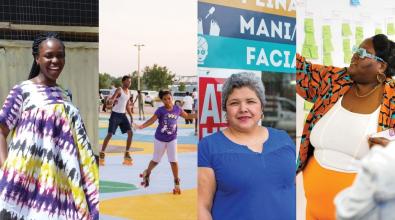 Read More
Read More
The next frontier for taking on safety-net stigma in cities

Listen to This Article
Local leaders are always creating new ways to help residents better make ends meet. Whether it’s Istanbul’s “Pay it Forward” program, which enabled neighbor-to-neighbor assistance in paying utility bills, or greater Houston’s new guaranteed-income pilot, cities are a proving ground for innovative approaches at reducing poverty and improving quality of life.
Part of that work includes connecting people to the assistance that’s already available to them. For good reason, too, considering that as many as 50 percent of households in the United States don’t access the benefits they’re entitled to—in some cases because of the stigma associated with those benefits.
Now a promising new line of research from The People Lab at the Bloomberg Center for Cities at Harvard University is uncovering ways that an already familiar tool—the behavioral “nudge”—can help cities think more strategically and work more effectively in this space.
“Many efforts in behavioral science have focused on simplifying language, or making processes easier, taking as given the pervasive stigmatization of poverty, but not trying to address it,” says Elizabeth Linos, an Emma Bloomberg associate professor for public policy at the Harvard Kennedy School who worked on the research. “We're now starting to use the same tools to tackle the much thornier challenge of how to target and hopefully overcome the underlying stigma and shame associated with being on government assistance, within specific populations.”
Here’s how city leaders can put these tactics into action.
Recognize the power of proactive and subtle messaging.
The People Lab’s work tested strategies for increasing applications for rental assistance in Denver and Austin, Texas. They did so by exploring how thousands of residents in the cities responded to informational postcards (in Denver) and emails (in Austin) geared at informing them about the help that was available. Residents received one of two communications: The first appeal provided basic information about temporary and emergency rental assistance and how to apply. The second went a step further by emphasizing that there is no shame in needing assistance.
While both communications appeared to increase applications for rental assistance, the second was most successful, and potentially more so for Black and Latino residents. The findings suggest more nuanced outreach at the city level can bolster faith in government, according to Linos, who led the research together with Jessica Lasky-Fink, research director at The People Lab.
“There are many ways that we can incorporate this into how we think about delivery of services,” Linos says. “What our findings suggest is that even small tweaks to how we talk about the program, or how we talk to people who are potential beneficiaries, does make a difference.”
Improve people’s experience of applying for benefits.
The most successful approach in the study told residents who qualified for rental aid that “it’s not your fault” and encouraged them to “get the assistance they deserve.”
But, in addition to experimenting with these kinds of subtle language changes, cities can also tap internal resources to craft comprehensive approaches that incorporate behavioral nudges. “There are a lot of cities who do have expertise in house to do this kind of work—and if not, have been trained enough to know when to ask for outside help,” Linos says.
Linos recommends cities consider the implications for different groups of residents. Some appeals may work better for mostly white communities, while others work best for residents of color; in the study, the language changes geared at reducing stigma seemed to have a larger, dramatic impact among Black and African-American residents, although additional research is needed. Also potentially helpful for city leaders is a broader awareness of the role stigma can play in city-resident interactions, and being open to testing different approaches to reducing this stigma.
“The big finding is not: Use this exact phrase that worked in this context, but to erect creative, institutional infrastructure to constantly think about what we put in words, and test what works best on an outcome that we care about,” Linos says.
Build upon existing efforts and datasets.
City leaders already have powerful tools close at hand to help them increase the number of residents applying for and receiving benefits. One of them is data: Application requests, for instance, are often part of local administrative records, and are a treasure trove of information. The People Lab work in Denver tapped data from the county Department of Housing Stability.
And because many cities are already connecting with residents about benefits, refining and testing fresh approaches doesn’t necessarily require spending more money.
“Just a simple thing, like adding in a URL so that you can measure whether or not one [online appeal] versus another has different click-through rates, doesn't add cost,” Linos says.
If cities can improve use of benefits by breaking new ground in addressing stigma with tools like these, it will amount to fresh proof of just how effective they can be when they serve as platforms, rather than just providers.
“Whether you call this customer experience or human-centered design, or behavioral science, the principles are the same,” Linos says, “which is we want to create policies and programs that work for residents in the way that they actually behave.”

